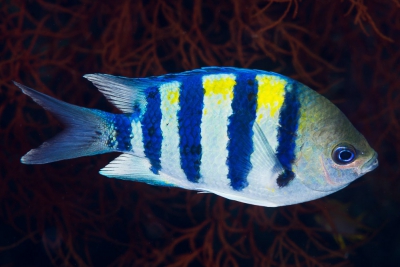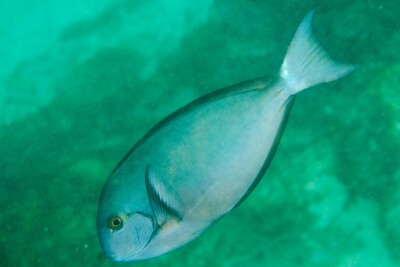royal dottyback
| Family | Pseudochromidae |
|---|---|
| Genus | Pictichromis |
| IUCN category (World) | LC |


Introduction
Pictichromis paccagnellae, commonly known as royal dottyback, is a tropical marine fish found in the Indonesian region and the western Pacific Ocean. This colorful species is highly sought after in the aquarium trade without being threatened in its natural habitat.
Who is it?
Morphology
-
Average size6 cm
-
Maximum size7 cm
-
Longevity5 year
-
Average size6 cm
-
Maximum size7 cm
-
Longevity5 year
How to recognize This fish ?
The royal dottyback is bi-colored in yellow and pink to purple. The color division starts from the middle of the back to the base of the anal fin. The color extends more translucently on the dorsal, caudal, anal, and pelvic fins. The body is elongated, slightly laterally compressed.
This species can be confused with Pictichromis coralensis, Pictichromis dinar or Gramma loreto.
Sexual dimorphism
There is no apparent dimorphism in this species.
Behaviour & Life cycle
-
dietcarnivorous
-
Sociabilityliving in a group or alone
-
territorialYes
-
Way of livingdiurnal
The Pictichromis paccagnellae is a fish that lives hidden among rocks. It is a territorial species that does not tolerate its conspecifics. It can be aggressive towards other species.
This micropredator eats any prey that can fit into its mouth, such as small fish and invertebrates.
Reproduction
-
Reproductionovipare qui pond sur substrat caché
The Pictichromis paccagnellae is an oviparous fish that spawns on hidden substrate. Like most wrasses, the male prepares a nest in which the female will lay eggs. He protects and takes care of the spawn until the eggs hatch.
Harmless species
This species does not pose any particular danger to humans if encountered in its natural habitat.
Origin and distribution
What is its habitat?
Natural environment characteristics
-
Temperature22 - 26 °C
-
Depth1 - 50 m
Biotope presentation
The Pictichromis paccagnellae is most commonly found at depths of less than 50 meters. It is often present up to 15 meters.
Royal dottybacks frequent coral and rocky bottoms of coral reef areas. Crevices in rocks are shelters that allow them to seek safety and build their nest.
Species of the same biotope
Main recommendations for fishkeeping
Deontology
In order to preserve wildlife, if you acquire this animal, it must not be released into the wild. See also, the Fishipedia charter.
Fishipedia supports the practice of responsible and environmentally friendly aquarium keeping. We encourage maintenance if it is motivated by a desire to understand the biological functioning of living things and if it is done with respect for animal life.
We believe that aquaristics is an opening to the discovery of aquatic environments, especially freshwater, and that this knowledge is necessary to better protect and respect these environments. Logically, we refute the compulsive purchase of animals that would not find a sufficient and / or adapted place in the host aquarium.
Our recommendations
-
Min volume110 liters
-
Population minnot specified
-
Temperature22 - 26 °C
-
pH (acidity)8.2 - 8.4
Characteristics
-
Difficulty breedingmoderate
-
Behaviourslightly aggressive
General reminders
It is strongly advised to read the complete dedicated file and to get information on the feedbacks of maintenance of the envisaged animal, this to avoid any potential conflict whose end result is generally the death of the individual (or the other inhabitants). It is important not to overload your aquarium to limit pollution. This will make maintenance easier.
General reminder on maintenance datas
Le démarrage d'un aquarium est une partie primordiale pour l'équilibre et le bien-être des poissons. Lorsque l'on met en eau un aquarium, l'eau passe naturellement par un cycle biologique : le cycle de l'azote. Celui-ci dure environ trois semaines. Tous les 2 jours, nous vous conseillons de tester votre eau jusqu'à ce que le taux de nitrite soit à zéro pendant plusieurs jours d'affilée.
Pour accélérer ce cycle, vous pouvez utiliser un activateur de bactéries comme JBL Denitrol. Cette solution riche en bactéries vivantes et enzymes permet une mise en place rapide du cycle de l'azote. Les poissons peuvent alors être introduits plus rapidement.
Il est important de tester l'eau de son aquarium régulièrement pour maintenir un environnement sain pour les poissons et les autres habitants. Les tests d'eau permettent de mesurer les niveaux de différents paramètres tels que le pH, la dureté totale, ainsi que les taux de nitrates, de nitrites et d'ammoniaque.
Pour réaliser ces tests, vous pouvez utiliser des produits d'analyse spécialisés tels que JBL ProScan qui permet de réaliser un diagnostic de l'eau directement via un smartphone. Il existe également des coffrets de tests plus classiques de bandelettes, comme JBL PROAQUATEST.
En cas d’usage de l’eau du robinet, vous pouvez utiliser un conditionneur d’eau de type Biotopol de JBL pour éliminer les substances nocives comme le chlore, le cuivre, le plomb et le zinc. Une eau trop dure ou trop calcaire peut être inadaptée à de nombreuses espèces tropicales d’eau douce. Si nécessaire, vous pouvez la couper avec de l’eau osmosée ou de pluie filtrée afin d’obtenir une dureté plus adaptée aux besoins de vos poissons et de vos plantes. Les conditionneurs d'eau garantissent une meilleure santé aux poissons et une meilleure croissance des plantes.
Chlorine and chloramine are dangerous for the health of animals. Used to disinfect water, these agents are present in significant quantities in tap water. We recommend using an anti-chlorine agent every time you change the water. In addition to chlorine, treatments and medicines sold for aquarium use sometimes contain dangerous heavy metals in high doses.
Specific needs for the royal dottyback
The royal dottyback is a marine species which lives naturally at a temperature between 22 °C and 26 °C. Nitrate levels should remain below 50mg/L. To keep the water clean and unpolluted, plan on changing 20% to 30% of the water volume each month. In seawater, it is also possible to remove nitrates using one of the following methods: Jaubert, denitrator on sulfur, biopeletts, vodka method.
The breeding of this species is accessible on condition of being well informed about its needs in aquarium . Any cohabitants must be chosen with care to avoid the loss of animals.
Cohabitation & Environment
In a community aquarium context, this species should be kept in a minimum volume of 110 liters.
The royal dottyback may show signs of aggression. In general, this species should not be mixed with large territorial species or other overly aggressive species, in order to avoid possible stress or even injury.
However, it can coexist with other species with a peaceful temperament and with some slightly territorial neighbors, as far as the volume of the aquarium allows. It is important to avoid that two territorial species share the same living area in an aquarium of insufficient volume. During the breeding season, this species defends its territory with more virulence. This behavior can weaken its shy neighbors.
To best reproduce the biotope of this species, you can cover the bottom of the tank with sand and put a pile of stones to form caves.
Tips for feeding
The royal dottyback is carnivorous.
This species can eat dry food (flakes, pellets), fresh food and frozen food. To avoid deficiencies, it is recommended to vary the types of food.
Feed animals in moderation to maintain good water quality. Meals should be eaten within 2–3 minutes, served in several small portions rather than a single large ration.
Uneaten food quickly decomposes, releasing ammonia, nitrites, and nitrates, which disturb the aquarium’s biological balance.
Make sure each species can access food properly, slower or bottom-dwelling individuals may require targeted feeding.Reproduction protocol
-
Spawning cleaningMale
-
egg-laying protectionMale
-
Fry protection
Hybridization risks
In general, it is advised not to mix several species of the same genus or different varieties of the same species, to avoid the risks of hybridization.
These animals might interest you
To go further
Sources & Contributions
Participation & Validation
The Fishipedia team and specialist contributors are committed to providing high-quality content. However, although the information comes from scientific sources or testimonials from specialists, the cards may contain inaccuracies.

Adrien Falzon
Translation
Translation done with the valuable contribution of our translators, who make this information available to a wider audience. We sincerely thank them for their commitment.
Bibliographic references
- - GBIF
- - Fishes of three North West Shelf atolls off Western Australia: Mermaid (Rowley Shoals), Scott and Seringapatam Reefs - Glenn Moore - Sue Morrison - Records of the Western Australian Museum - 2009.
- - Checklist of the species of the Indo-Pacific fish family Pseudochromidae - Paolo Parenti - ResearchGate - 2019.
- - Depth and reef profile: effects on the distribution and abundance of coral reef fishes - M. W. Jankowski - N. R. Gardiner - G. P. Jones - Springer Nature - 2014.
- - The complete mitochondrial genome of the Royal dottyback Pictichromis paccagnellae (Perciformes: Pseudochromidae) - Jing Huang - Qiong Wang - Wan Shu Hong - Kang-Ning Shen - Shi Xi Chen - - 2015.
Scientific partners
Tags
Species of the same family
Same genus
Species of the same biotope

































